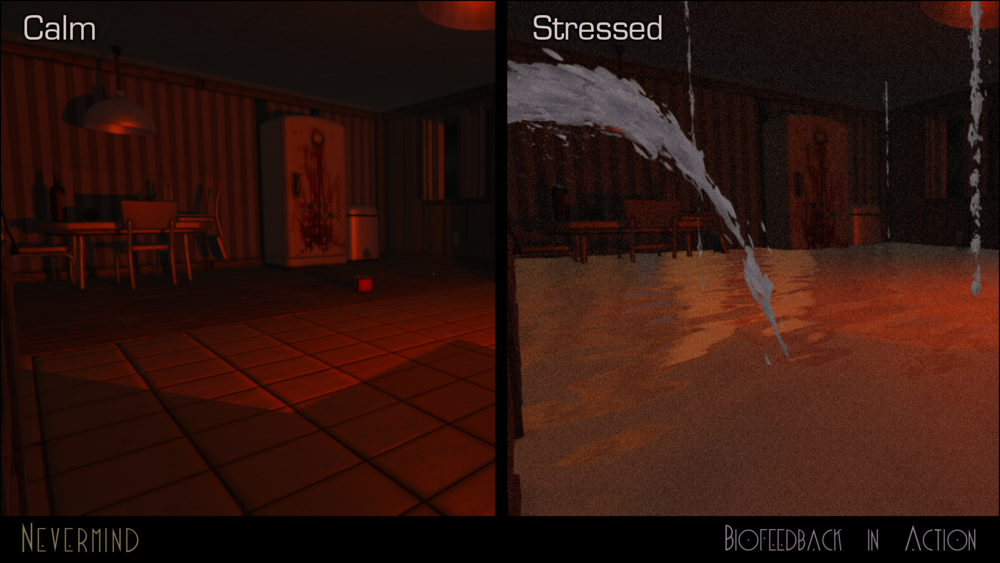Media - Video Game - Nevermind (2015)
/cdn.vox-cdn.com/uploads/chorus_asset/file/3465304/Screen_Shot_2015-03-03_at_8.54.32_AM.0.png)
Nevermind (2015) is a VR supported horror game that deals with trauma memory recovery. The premise is fairly simple: You play as a researcher or "Neuroprober" who goes into the minds of traumatized individuals and helps piece together the scattered fragments of the subjects traumatic memory so that they can begin the process of reassembling and over-coming their PTSD symptoms. The game, being told from the perspective of a health care professional, is apparent in the clinical way the subjects are treated. While you do delve into the minds and backstories of multiple people, it is done so in a very third person way (in spite of the game literally taking place in 1st person). As you wander through a fairly linear path, you come across fragments of the traumatic memory in the form of photographs. Each of these photos tells a small snippet of memory, some relevant, some irrelevant to the trauma. Once you find all ten photos, you then piece together the 5 relevant fragments to create a linear story of the trauma they experienced.
The on-boarding process, while thorough, is quite involved as you are led step by step through how the mind probing works and what to do. The explanation can get tiresome, and could be paired down to much more simple means, particularly as the training mind you go into is that of Hansel from the fairy-tale Hansel and Gretel. As hokey as the first story is however, the first real mission is where things start to come together. You traverse the mind-scape of a woman who witnessed her father's financially motivated suicide. The puzzles here are clever and the game gives up all pretense of hand-holding. The player now has to traverse an increasingly abstract and horrifying set up with no guidance whatsoever, sometimes causing stalls in progress that leave the player themselves feeling as though they have hit a wall.
One of the more interesting mechanics of the game is one most won't be able to fully experience. While I was able to get the web camera monitor functioning, I did not have the requisite nodes to collect heart-rate data. This stunts the game a bit, as when played with a fully functioning set of monitoring devices, the environment will alter and change with your own emotional state. While the webcam did sometimes result in my environments becoming increasingly disorienting and anxiety inducing, it was much harder for the webcam alone to interpret my emotions. When these emotions are triggered, however, the game actively tries to make the run harder to complete as seen in the image below. When used to full effect I imagine that the immediate feedback in the game of your own emotions would create a much more visceral experience.

Included in the game's menu screen are safe relaxation spaces and "spas" where players can go to relax or perform breathing exercises. It is implied in the game's menu that if the player's vitals show too high a state of arousal, the game will actually place the player immediately into one of these spaces until they calm down, which seems smart thinking for a game delving deeply into intense trauma.
From the mechanics to the game play loop, it appears that Nevermind functions dual as an exploratory found story experience and as a training tool relating to trauma. This latter reason is actually why I looked at it to begin with, though its methodology seems more in line with training future psychologists or others who work with people suffering from PTSD rather than working with the patients themselves. While I don't necessarily think that the narrative has a flawed premise, its the ultimate payoff that seems lack luster. While remembering forgotten memories of trauma can be vital to a patients healing process, remembering your trauma alone, as I have looked at all semester, does not heal it. The characters in the game are clearly just at the beginning stages of working through their trauma, but the AHA! moments scattered throughout the game come off as disingenuous resolutions to their PTSD, and I don't think it is made clear enough that the mind-probing process would have to be one step of many patients would need to go through.

Comments
Post a Comment